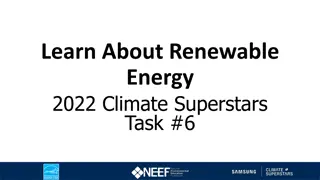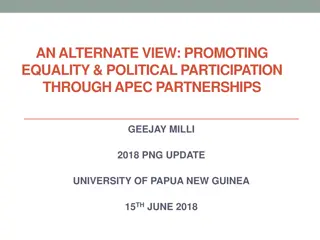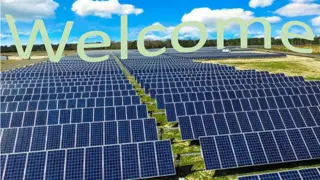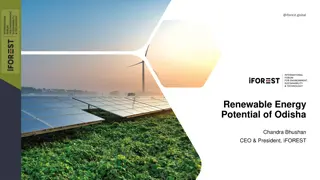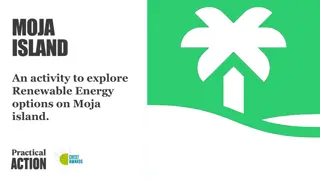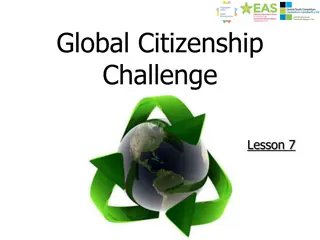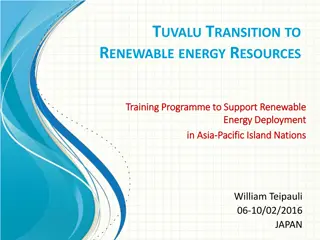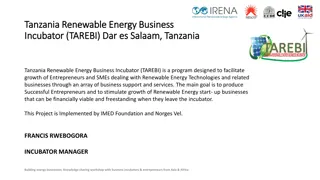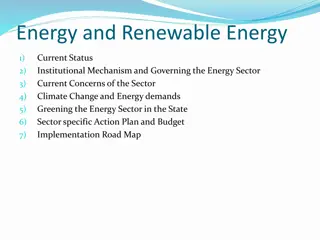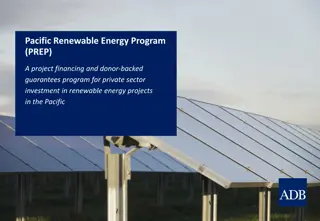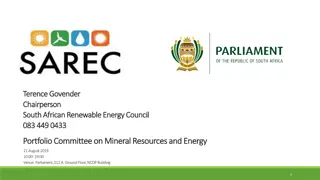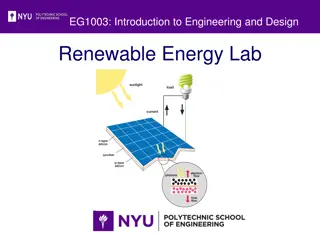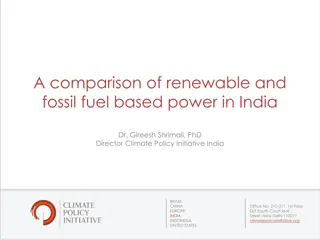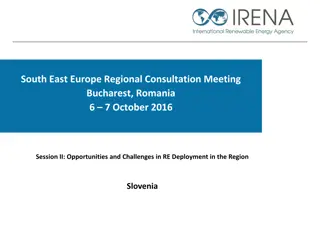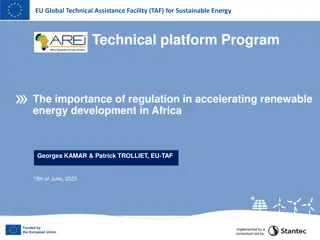Unlocking Renewable Energy Potential in the APEC Region: Towards Doubling by 2030
The APEC Energy Ministers aim to double the share of renewables by 2030, emphasizing clean energy access and reducing energy intensity. Challenges such as economic variations and political conditions exist, but workshops and initiatives focus on renewable energy advancement, innovative financing, and capacity building to prepare economies to meet the 2030 renewable energy goal.
Download Presentation

Please find below an Image/Link to download the presentation.
The content on the website is provided AS IS for your information and personal use only. It may not be sold, licensed, or shared on other websites without obtaining consent from the author. Download presentation by click this link. If you encounter any issues during the download, it is possible that the publisher has removed the file from their server.
E N D
Presentation Transcript
WORKSHOP ON EXPERIENCES AND WORKSHOP ON EXPERIENCES AND PLANS TO DOUBLE RENEWABLE PLANS TO DOUBLE RENEWABLE ENERGY UTILIZATION BY 2030 ENERGY UTILIZATION BY 2030 I I THE APEC REGION (EWG 05 2015A) APEC REGION (EWG 05 2015A) THE ISES SOLAR WORLD CONGRESS 2015 ISES SOLAR WORLD CONGRESS 2015 NOVEMBER 8 12, DAEGU, KOREA I S E S S O L A R W O R L D C O N G R E S S 2 0 1 5 I S E S S O L A R W O R L D C O N G R E S S 2 0 1 5
we endorse the Energy Ministers aspirational goal to double the share of renewables including in power generation by 2030 in APEC s energy mix. We affirm our commitment to rationalize and phase out inefficient fossil fuel subsidies that encourage wasteful consumption while still providing essential energy services.
APEC Energy Ministerial Cebu, the Philippines, October 2015 Ministers technologies, energy efficiency and low carbon initiatives, and renewable energy development and deployment to further progress toward the Leaders goals of reducing energy intensity by 45 percent by 2035 and doubling renewable energy by 2030 in the region. Ministers emphasized the need to increase energy access, particularly in remote communities, and noted the benefits of microgrids, energy storage, and integration of renewables into the grid. They welcomed the activities already undertaken by the Energy Working Group and strongly encouraged the acceleration of renewable energy projects to further progress toward the Leaders renewable energy goal. stressed the importance of clean energy
CHALLENGES Economies of different sizes and level of advancement Geographical variations Political conditions Energy priorities Economic conditions Needs of people and society
APEC RENEWABLE ENERGY WORKSHOP November 10-11, 2015: Daegu, Korea Currents trends and barriers including policy, technical, and social to advancing renewable energy Opportunities and strategies for strengthening renewable energy implementation: emerging technologies, innovative financing, public-private partnership, and business strategies Best practices for advancing renewable energy: training for capacity building, reducing soft costs, resources for information sharing, and stakeholder engagement Guidelines for economies to prepare a roadmap to DOUBLE renewable in the energy mix by 2030.
WORKSHOP AGENDA Presentations by experts on global projections for renewable energy, projections and consequences for the APEC region, system integration and flexibility issues, renewable energy for buildings, and green technologies Experiences and plans by delegates from Korea, China, Chinese Taipei, Japan, Malaysia, Papua New Guinea, Peru, Philippines, Thailand, Vietnam
INITIAL WORKSHOP SUMMARY Economy suggestions from Current trends and barrier group Group priority recommendations oCurrent trends and barriers oOpportunities and strategies oBest practices Summary recommendations
CURRENT TRENDS AND BARRIES CURRENT TRENDS AND BARRIES INCLUDING POLICY, TECHNICAL INCLUDING POLICY, TECHNICAL AND SOCIAL TO ADVANCING AND SOCIAL TO ADVANCING RENEWABLE ENERGY (1) RENEWABLE ENERGY (1) Malaysia Carrot & stick (only carrot does not work) RE act addresses technical barriers (esp. local capacity) Capacity building important RE fund comes from end-users awareness raising was important to inform consumers (regular information days, information at schools etc.) Tightening/improving the rules over time to give fair & transparent access to funds Malaysian banks: RRI should be at least 12 %, below they are not interested to invest in RE
CURRENT TRENDS AND BARRIES CURRENT TRENDS AND BARRIES INCLUDING POLICY, TECHNICAL INCLUDING POLICY, TECHNICAL AND SOCIAL TO ADVANCING AND SOCIAL TO ADVANCING RENEWABLE ENERGY (2) RENEWABLE ENERGY (2) Korea Slow reaction from government to correct market failures Large RE industry is doing well, SMEs more averse to taking up opportunities to go abroad Consumers are interested in renewables but not so prepared to make themselves investment in renewable energy Low electricity price for industry
CURRENT TRENDS AND BARRIES CURRENT TRENDS AND BARRIES INCLUDING POLICY, TECHNICAL INCLUDING POLICY, TECHNICAL AND SOCIAL TO ADVANCING AND SOCIAL TO ADVANCING RENEWABLE ENERGY (3) RENEWABLE ENERGY (3) China Backbone in RE: hydro, wind and solar Hydro & wind are mature, solar is booming PRC swiches from export oriented market to domestic market Implementation of RE policy at local level should be encouraged (local governments need to realise the importance of RE) Promotion of feed-in tarriffs by central government, only part of local governments provide similar incentives Government puts much emphasis on R&D Chinese population has strong support for RE as a means to mitigate environmental problems Focus on large utility-scale projects Curtailment still an important issue / integration of RE a priority for the government
CURRENT TRENDS AND BARRIES CURRENT TRENDS AND BARRIES INCLUDING POLICY, TECHNICAL INCLUDING POLICY, TECHNICAL AND SOCIAL TO ADVANCING AND SOCIAL TO ADVANCING RENEWABLE ENERGY (4) RENEWABLE ENERGY (4) Peru Stronger policy focus on diversification of energy mix (currently a lot of focus on biofuels) Lack of financial incentives Weak relationship between academia, industry and government (PPP) Poor communication between different ministries No incentives for solar energy devices (only off-grid) Lack of availabilty of resources to finance projects Need for continuous training of workforce (few training opportunities) Need to create more awareness about the positive impact of renewable energy Language barrier (native language vs. Spanish/English) RE goal of 5 % by 2013 is not being reached (currently at 2%)
CURRENT TRENDS AND BARRIES CURRENT TRENDS AND BARRIES INCLUDING POLICY, TECHNICAL INCLUDING POLICY, TECHNICAL AND SOCIAL TO ADVANCING AND SOCIAL TO ADVANCING RENEWABLE ENERGY (5) RENEWABLE ENERGY (5) Thailand Regular change of Minister causes disruption in the policy framework Need to import technologies & expertise from abroad not enough capacity in the country Electricity grid needs to be more expanded to integrate renewable energy sources Lack of awareness (e.g. misbelief that solar panels chase away the rain)
OPPORTUNITIES AND STRATEGIES OPPORTUNITIES AND STRATEGIES FOR STRENGTHENING RENEWABLE FOR STRENGTHENING RENEWABLE ENERGY (1) ENERGY (1) Malaysia Scheme by government providing soft loans (not yet existing in Malaysia) Government provides interest subsidies, project developers still need to find conventional funding, banks are often reluctant to finance RE projects (slowly getting better) Setting-up of SEDA (dedicated agency to facilitate RE deployment)
OPPORTUNITIES AND STRATEGIES OPPORTUNITIES AND STRATEGIES FOR STRENGTHENING RENEWABLE FOR STRENGTHENING RENEWABLE ENERGY (2) ENERGY (2) Korea Energy storage is a key enabler for RE deployment to stabilise the grid Focus on service of generating electricity rather than incentive
OPPORTUNITIES AND STRATEGIES OPPORTUNITIES AND STRATEGIES FOR STRENGTHENING RENEWABLE FOR STRENGTHENING RENEWABLE ENERGY (3) ENERGY (3) China Promoting new energy demonstration zones (e.g. on town or city level are granted special rights as test zones such as New Energy Demonstration Cities Programme) Distributed PV demonstration parks/zones Programme Electrical vehicles Graphene for innovative battery technologies Energy generation through nano carbon tubes (new marine energy technology) Innovative PPP financing
OPPORTUNITIES AND STRATEGIES OPPORTUNITIES AND STRATEGIES FOR STRENGTHENING RENEWABLE FOR STRENGTHENING RENEWABLE ENERGY (4) ENERGY (4) Peru Training of staff to implement projects Creation of awareness about benefits of renewable energy (e.g. through ecomarkets in Lima) Awareness campaigns in schools and universities Incentives for companies investing in environmental measures Best practise: promotion of RE in rural areas
OPPORTUNITIES AND STRATEGIES OPPORTUNITIES AND STRATEGIES FOR STRENGTHENING RENEWABLE FOR STRENGTHENING RENEWABLE ENERGY (5) ENERGY (5) Thailand Zones for different RE technology deployment ESCO approached replicated for RE Solar pumps as merging technology to address increased frequency of draughts
MOST IMPORTANT ISSUES MOST IMPORTANT ISSUES APEC SHOULD ADDRESS IN APEC SHOULD ADDRESS IN FUTURE (GROUP 1) FUTURE (GROUP 1) Electricity market reform (remove subsidies from conventional fuels) Education to facilitate reaching doubling of RE goal More coordinated approach in achieving the doubling goal APERC could work on reporting on progress towards the RE doubling target More collaboration among different APEC working groups
THEME PRIORITIES THEME PRIORITIES Current trends and barriers oCost of renewable energy Opportunities and strategies oNeed to keep policy makers informed Best practicies oEncourage international/interegional information exchange Technical Policy Academic
PRIORITY ISSUES TO ADDRESS Education, training and information exchange Market and cost of renewable energy Inconsistent policies and incomplete understanding by policymakers Leverage advances in smart grid and storage technologies Strategic and innovative financing for bankable projects


